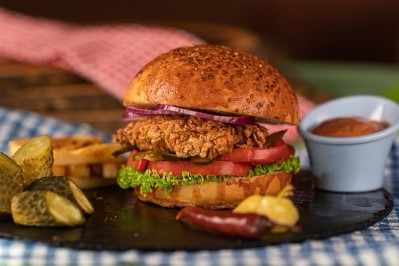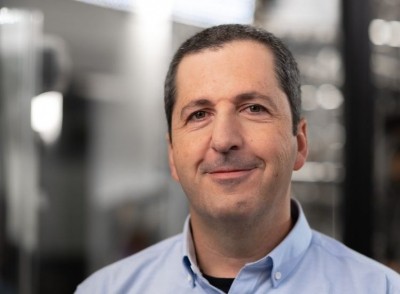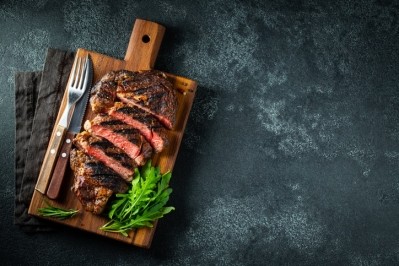WATCH: SuperMeat CEO on cultivated meat metrics: ‘We have a trajectory to cost parity, and I'm not just talking about beef, I'm talking about chicken…’
This content item was originally published on www.foodnavigator-usa.com, a William Reed online publication.
Of the cultivated meat startups out there, “only around 10-15” have demonstrated their process at pilot scale, and SuperMeat is one of them, claimed co-founder and CEO Ido Savir. “This says what I'm doing is not a science experiment anymore, it's an industrial process, and you can also show a trajectory to cost parity and large scale production.”
SuperMeat is currently producing meat at a plant in Rehovot (pictured in the video above) which “has the capacity essentially to support us in working with our partners, developing different kinds of applications and validating them before market launch,” said Savir, who has built a team of 40+ people to date.
“Then we're working with different partners in the US [with a view to] co-manufacture there to do the first run of products in the market, which we expect will be in early 2024, and we believe by then we'll get regulatory approval. Alongside that we're intending to build our large industrial scale plant in the US.”
‘We're not using scaffolds and carriers’
The key to the firm’s strategy is simplicity, said Savir: “We're not using scaffolds and carriers, and the great advantage of that means we can repurpose existing facilities and leverage the incredible industrial knowledge that's out there…
“[It also means that] the output is 100% animal protein without any kind of foreign material integrated within it. What is important for us as a b2b player, is that food companies receive the same thing from us as they are used to getting from the traditional [meat] industry.”
So how does it work?
He explained: “At stage zero you establish the cell bank, and as we're using stem cells which are inherently immortal, we don't need to go back and replenish that cell bank.
“We then take cells and put them into the main fermentation facility… now you've got a load of [cell] mass. One of the greatest advantage of this kind of system, which is exponential in nature, is that the cycle time is less than 24 hours, so each day, you can harvest half of that to a sequential fermentation facility that directs the cells to muscle or fat… and the next day when you come back to the main fermentation facility, you have a full capacity again to draw from.
”So every day you can produce a new batch of your full capacity of meat, and that creates a very high yield efficient system… a continuous production system.”
‘Our cells excrete their own scaffold’
To get the cells to differentiate and mature into more recognizably meaty forms without seeding them onto edible scaffolding or deploying bioprinting, he said, “Our cells excrete their own scaffold… they excrete collagen and other ECM [extra-cellular-matrix] related molecules that support them, and that's a core part of our technology that allows us to create something that we see as a much more similar process to what happens in the animal's body.
“An interesting demonstration of that is the nutrition profile, which shows an equivalence almost to conventional produce meat.”
Why start with chicken?
But why start with chicken, which is already a very cheap source of protein, vs something with a more premium price tag that would provide more margin before the process is scaled?
According to Savir: “I think besides the obvious that chicken is the most sought-after protein everywhere in the world, which I think is important, also chicken in the US and in Israel is considered the most contaminated animal protein out there with E. coli, salmonella and the rest, and receives the most antibiotics. Today, even in this pilot facility, we are completely antibiotic-free.
“In terms of pricing, when we reach foodservice, which is our first category, we intend to be at price parity with current products.”
Investor attitudes
Asked whether the slowdown in plant-based meat has made investors more anxious or more gung-ho about cultivated meat, he said: “Generally speaking it's made people more excited about cultured meat because before, we would receive more questions like why do we need this when we have great plant-based products?
“I think what we will see is that actually the combination of these two worlds can achieve incredible things.”
The consumer proposition for cultivated meat
So what does he think will resonate with consumers when it comes to cultivated meat?
“I think we won't know until we actually hit the market,” he said, “so it will be very interesting to see. I think like Bruce Friedrich [co-founder at the Good Food Institute] always says, the first three things you need to make sure you have are taste, convenience and cost.
“Then I think there's more awareness from consumers to better understand how their food came to the table, and that's where I think the food industry in general and specifically cultivated meat and all the new industries have the burden to have much higher quality standards, whether it's transparency, traceability or nutrition, so people will say this is a whole new level of quality that we can get from our food.”
On an industrialized scale, ‘it's going to be… drastically more sustainable’ than conventional meat
On sustainability metrics and cultivated meat, he claimed, “When you have a fully industrialized facility… then you know it's going to be… drastically more sustainable.
“And whatever we quantify in the first stage, there's going to be much more that we'll be able to achieve, because there's so many supporting industries that you can leverage, whether it's side streams, localization of the supply chain, recycling, upcycling, alternatives solutions for energy. Once you have a fully industrial system, this ocean of possibilities opens up.”
‘We have a trajectory to cost parity, and I'm not just talking about beef, I'm talking about chicken’
Asked about bioreactor size, he said: “We don’t know [what the sweet spot in terms of size is yet]. But we can predict that there will be a sweet spot at 100,000 liter volume for us for poultry, for example.
“For beef and others it may be lower. At 20,000 liters, it will be somewhat premium. But I can say with confidence that we know that at 100,000 liters we can reach cost parity with chicken. At 20,000 liters, we believe we can, but there's more unknown there.”
More generally, he claimed, “I can say with very high confidence, based on very detailed cost of goods analysis models that we have that are based on large scale industrial models that show that we have a trajectory to cost parity, and I'm not just talking about beef, I'm talking about chicken."
He added: “If you just look at the media, at the scale that the industry is at right now, the main cost driver is the growth factors, but in the long run, the basal media will be the main cost driver, which relates to our partnership with Ajinomoto, which is the largest global amino acid producer.”


















